As a home gardener, you understand the importance of using the right seed to get the plants you want. But when it comes to microgreens, there’s a different kind of seed at play: microgreen seeds.
These seeds may look similar to regular seeds, but they’re not always interchangeable.
To make sure you’re growing the best microgreens possible, it’s essential to know the differences between microgreen seeds and regular seeds.
In this article, we’ll help arm you with all the knowledge you need on microgreens and regular seeds — including what types of crops work best for each seed variety and tips for preparing your soil for either type.
Let’s dig in!
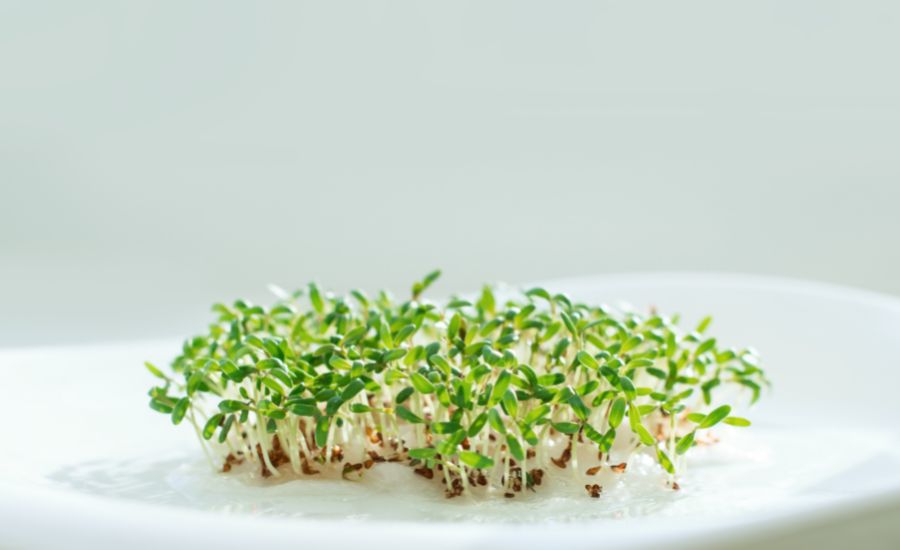
Contents
- 1 What are microgreens and regular seeds?
- 2 Are microgreens different from regular seeds?
- 3 Benefits of microgreen seeds
- 4 Choosing the right type of seed for your needs
- 5 Good candidates for growing microgreens
- 6 Can normal seeds be used for microgreens?
- 7 Can you use microgreen seeds to grow plants?
- 8 Can I use regular seeds for sprouting?
- 9 Conclusion
- 10 FAQs About Microgreen Seeds vs Regular Seeds
- 10.1 What is the difference between microgreen seeds and regular seeds?
- 10.2 Which type of seed has the most nutritional content?
- 10.3 Can normal seeds be used for microgreens?
- 10.4 Can you use microgreen seeds to grow full-size plants?
- 10.5 What kind of seeds do you use for microgreens?
- 10.6 Can I use regular seeds for sprouting?
What are microgreens and regular seeds?
When it comes to purchasing seeds for growing your produce, there are two main types of seeds you can use—microgreens and regular seeds. So, what’s the difference between the two?
Regular seeds are what you’d typically find at a garden center or online marketplace. These are full-sized plants that need to be grown from seed to harvest. You can think of regular seeds as the traditional way of growing your produce.
Microgreens are the same seeds as normal ones, but in a smaller version of the plant. While regular garden seeds take time to grow and require a lot of care and maintenance, microgreen seeds sprout quickly and have a more condensed nutrient value than their regular counterparts.
As a result, they’re becoming increasingly popular among home gardeners looking for an easier harvest solution.
It is important to notice that bird seeds are not the same as microgreens. Birdseed is often chemically treated before planting, and most, if not all the commercially packaged sunflowers are labeled “not for human consumption.”
This is a seed handling problem in that the FDA does not inspect the facilities that package bird seed.
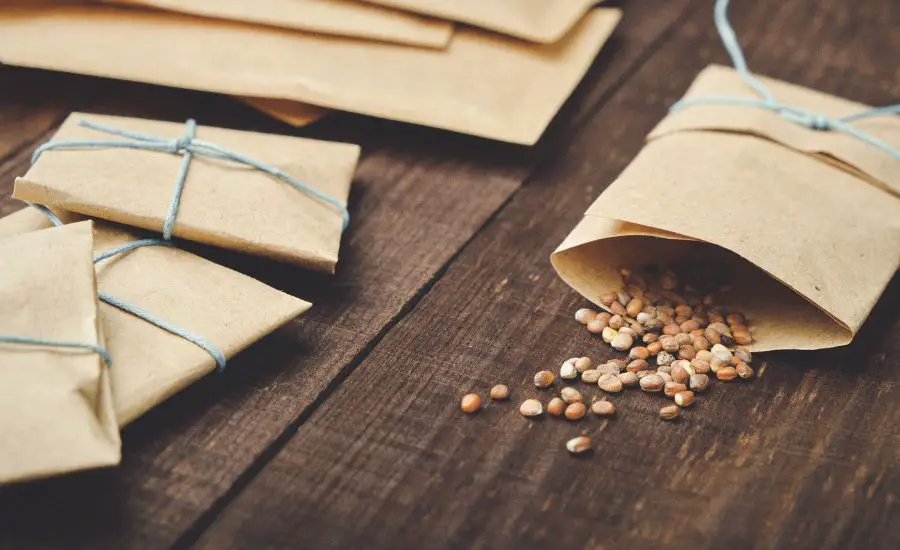
Are microgreens different from regular seeds?
Microgreen seeds are the perfect way to kickstart your garden. Not only do they come from nutrient-rich whole plant sources, but they also germinate quickly—in less than a week—and with minimal effort for a healthy dose of greens in no time.
So what sets microgreen seeds apart from regular seeds? To start, regular seeds contain both male and female reproductive organs and usually have a tougher outer shell, which requires stratification or scarification.
On the other hand, microgreen seeds only contain female organs and have a much thinner seed coat, meaning they can typically germinate without any extra preparation. So, here, microgreens seeds are almost no different from regular seeds.
Another key difference is that microgreen seeds produce smaller plants that don’t mature into full-sized vegetables, edible flowers, or herbs, while regular seeds will produce larger plants with full-size vegetables or herbs that you can harvest.
Additionally, microgreen seeds are meant to be harvested as soon as the first leaves appear and before the true leaves come in —regular seeds are meant to be left until the plant reaches maturity.
Popular examples of microgreens grown with herb seeds are cilantro, basil, and other microgreen herbs.
In sum, both regular and microgreen seeds serve their unique purposes depending on how you want to use them in your garden. Whether you opt for one option or mix it up with both types of seeds, you’re sure to get a bounty of goodies for your garden!
Benefits of microgreen seeds
When it comes to growing your food, the type of seeds you use will make all the difference. Regular seeds and microgreens come with their own unique set of benefits and drawbacks — let’s explore them here.
Packed with nutrients
The number one benefit of using microgreens is just how nutrient-dense they are. These tiny little powerhouses are packed with nutrition compared to regular seeds, as they contain vital vitamins and minerals like vitamins A, C, E, K, and B6, as well as folate and iron.
Another great thing about microgreen seeds is that they contain plenty of natural antioxidants, which help protect against free radical damage and can improve digestion.
That makes microgreens a great choice if you’re looking to increase your intake of essential nutrients, without having to take supplements or vitamins.
Faster grow time
The other great benefit of using microgreen seeds is that they have a shorter growth time — typically around two weeks! This means you can enjoy fresh greens much faster than if you were to sow regular plant varieties, which can take up to three weeks or longer for a harvestable crop.
This means less time spent waiting for your crops to mature — it’s almost instant gratification!
Plus, because the plants don’t have time to form large root systems or bolt (go to seed), microgreens are often more tender than their larger counterparts.

Choosing the right type of seed for your needs
If you’re looking to grow microgreens, the type of seed you choose is a big deal.
You want to make sure you select the right type of seeds for your needs—because there are more than just “regular” and “microgreen”.
While regular vegetable seeds can be used for microgreens, there are some specific seeds you want to use if you’re looking to get the most flavor and nutrition from your bounty.
Regular seeds
Most types of regular vegetable and herb seeds can be used to grow microgreens.
You can buy seeds on their own, or in pre-measured packages that have already been treated with fungicides and/or pesticides, if necessary.
No special seeds are needed to grow microgreens. It’s the environment that dictates how the plant will grow.
Microgreen seeds
Seed packets are specifically designed for growing microgreens, which means they are smaller than regular varieties and don’t require any additional treatment before planting.
This makes them a great choice for beginner gardeners who don’t have much experience measuring out tiny particles or applying pesticides.
You will likely find microgreen seeds sold as a mixture, which means you will be planting a variety of greens at one time that will all grow together. Some microgreen seed companies offer unique microgreen seed mixes that can’t be found anywhere else!
For example, one of the most commonly grown microgreens is the Swiss chard rainbow mix: This is the best and most inexpensive choice as a substitute for beets.
You can even grow microgreen flowers! It may be odd to imagine including young flower microgreens in certain foods, but they can add a surprisingly pleasing, floral taste to various microgreen mixes.
In addition, there are fewer seeds in a regular organic seeds packet than in a microgreens packet.
When deciding which type of seed is right for you, keep in mind that regular seeds will often give you a bigger harvest — up to five times more — but they require extra work beyond planting and harvesting.
Microgreen seeds take less effort, but will give you smaller yields, which might be better if you only want to grow a few plants at a time.
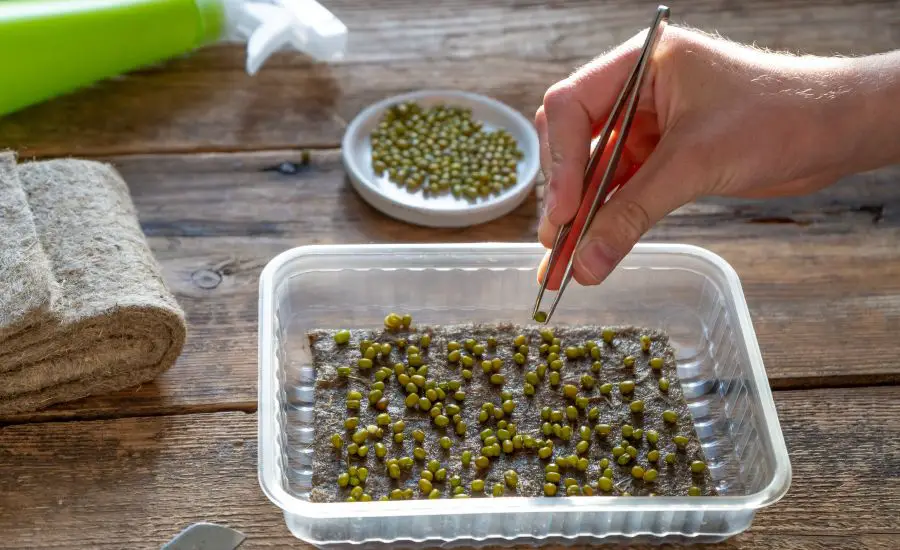
Good candidates for growing microgreens
When it comes to growing microgreens, you need to know what types are available and the variations among them.
The following are some of the most common varieties you can grow using microgreen seeds:
Leafy Greens
Leafy greens include kale, lettuce, spinach, and other types of lettuce. This variety is one of the best for growing in containers because they don’t require a lot of space or soil.
You can mix and match with different colors and flavors, depending on what you’re looking for.
Plus, since these greens tend to grow quickly, you’ll have your microgreens ready in no time!
Pea Shoots
Pea shoots are another type of microgreen that’s popular with chefs and home cooks alike. They’re easy to grow from seed and have a mild flavor that works as both a garnish or an ingredient in salads or cold dishes. Plus, they’re high in vitamins C and A, as well as fiber.
Radish
Grown from radish seeds, these tiny greens offer plenty of nutrition in a little package. They have a sharp flavor that pairs well with salads and sauces. Radishes are also incredibly easy to grow indoors.
By understanding how the different types of microgreens vary—including their flavor profiles— you can create the perfect mini-gardens for your kitchen or restaurant!
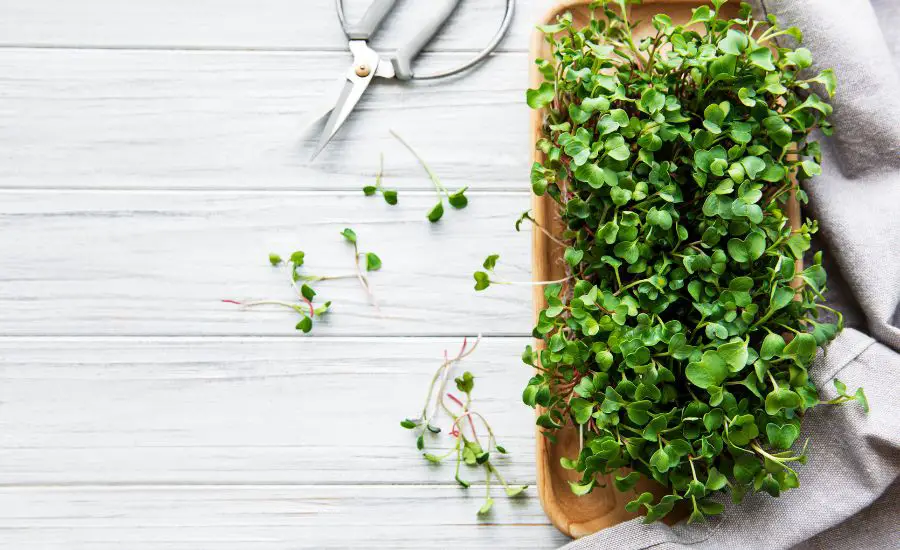
Can normal seeds be used for microgreens?
You may be wondering if you can use regular seeds for microgreens. The answer is yes, you can— but they won’t always make the best microgreens.
Regular seeds were designed to be planted outdoors and develop large, fully-formed plants.
Microgreen seeds, on the other hand, are specifically designed to create tender, young plants with intense flavors. If you use a regular seed packet in your microgreen garden, you might get a bit of a surprise!
Here are some reasons why using microgreen seed mixes makes sense:
- Microgreens are usually much smaller than their outdoor counterparts because they need to germinate faster in a confined environment.
- They also tend to have higher concentrations of essential nutrients compared to regular outdoor garden varieties.
- In addition, microgreen vegetables often have more intense flavors than regular vegetable varieties when harvested at baby-leaf stage size.
So while it’s possible to use a regular vegetable garden seed to grow your own microgreens, using special seeds for microgreens will give you the best results in terms of plant size, flavor, and yield.
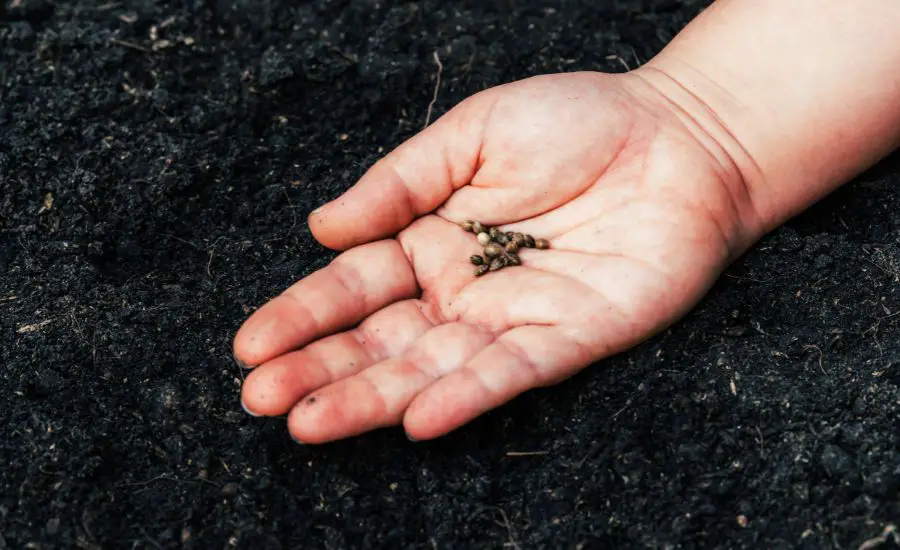
Can you use microgreen seeds to grow plants?
You may be wondering if planting microgreens can be used to grow plants. And the answer is, it depends.
Most microgreen seeds are culinary varieties, like arugula and kale seeds, and these have not been bred for their ability to produce full-sized plants that will flower and yield an edible crop.
That said, some types of microgreen seeds will produce edible full-sized vegetable plants when grown properly.
For example, some root vegetables like radishes can be grown from microgreen seed packets with the right materials and care.
Materials needed:
- soil mix (for container planting) or garden bed
- tray or pot
- microgreen seeds
- watering container with a small nozzle
Care instructions:
- Ensure the soil mix is moist before planting your microgreen seeds.
- Spread the microgreen seeds evenly over the surface of the soil.
- Cover the top thinly with another layer of soil and lightly sprinkle water over it using your watering container featuring a small nozzle/sprinkler attachment to ensure even coverage of moisture without disturbing the seed placement too much.
- Place in an area that receives plenty of natural light (preferably 6+ hours).
- Water in moderation every two days, ensuring that your soil remains moist but not overly wet to avoid fungal problems associated with excessive moisture over a prolonged period.
- After germinating the seeds, transfer the sprouted seeds to a large enough pot or a garden bed.
- When your plant reaches full growth, you can harvest them accordingly as you would any other vegetable variety!
Can I use regular seeds for sprouting?
The answer to this one is… maybe. You can certainly try, but the risk is high. Regular seeds are meant for long-term growth, not sprouting seeds, so it’s difficult to know how long it will take for them to germinate, or even if they’ll germinate at all.
Microgreens are specifically designed with sprouting in mind—you know exactly when your harvest will be ready, and what type of quality you’ll get as a result.
That’s why it’s best to stick with microgreens if you want full control over the quality of your harvest.
When choosing a seed packet, you have lots of options — from traditional varieties like kale and arugula to more exotic microgreens like basil and sorrel.
Whether you’re a pro gardener or just starting, there are a lot of options available to suit your needs and preferences.
Plus, when you plant microgreen seeds, you may harvest them in as little as 7-10 days!
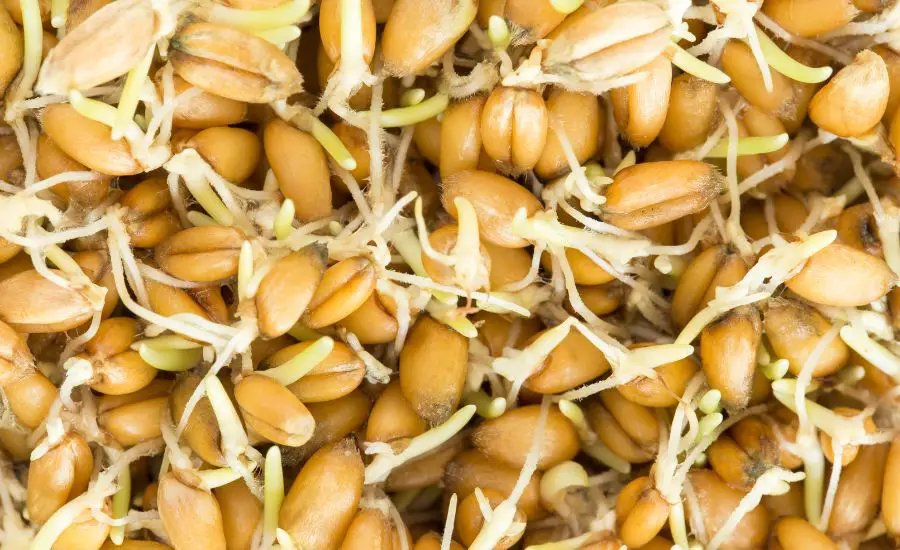
Conclusion
All in all, whether you choose to buy microgreen seeds or regular seeds is up to you. What matters is that you get the type of seed that best suits your needs and desired flavor profile.
As you can see, growing regular seeds into microgreens can be quite easy, to the point that you don’t have to buy microgreen seeds.
However, if you’re looking for something a bit more unique, then growing microgreens might just be the best option.
They can provide you with an abundance of flavor and nutrition in a single, compact sprout, and they reward your hard work with remarkable results.
FAQs About Microgreen Seeds vs Regular Seeds
What is the difference between microgreen seeds and regular seeds?
Regular plant seeds can average around 4 to 5 millimeters in diameter, while microgreen seeds can be as small as 1 to 2 millimeters in diameter. When you use regular seeds, harvesting is time-consuming because you have to weed out the unwanted seedlings.
With microgreens, however, you can scatter a higher quantity of seed per square inch, which means less time weeding out unwanted plants.
Which type of seed has the most nutritional content?
Microgreens are known for their high nutritional content when compared to regular seeds.
One study found that certain microgreens like cilantro contain 40 times more nutrients than lettuce! That means that by using microgreen seeds instead of regular ones, you can get even more nutrition out of your planting projects.
Overall, there are some key differences between microgreens and regular seeds in terms of size, nutrition, and harvesting time that should be considered when choosing which type of seed to use.
Can normal seeds be used for microgreens?
Yes, you can grow microgreens from almost any normal seeds. These are similar varieties grown in the garden or at the supermarkets. It also means there’s nothing special about microgreens. Microgreen plants can grow in nearly any variety.
Can you use microgreen seeds to grow full-size plants?
Maybe microgreens are aimed at gardens, and maybe not. This is not to say they cannot get fully grown plants—most of them can be grown into an ordinary full-length tree in a garden if they have been used for this purpose.
What kind of seeds do you use for microgreens?
Beginners usually begin by growing one type of seed — namely, broccoli and cauliflower — in a single container.
You can grow many tasty seed sprouts, ranging from legumes, leafy greens, nuts, and grains to brassica and grasses. It is possible that a person can produce seeds in many containers on the same day.
Can I use regular seeds for sprouting?
Just about any vegetable or herb seed can be sprouted and eaten in its newborn stage, though there are some usual suspects perfect for this purpose, including alfalfa, sunflower, fenugreek, and radish, as well as legumes.
Read More: Do you Need Special Seeds for Microgreens?



